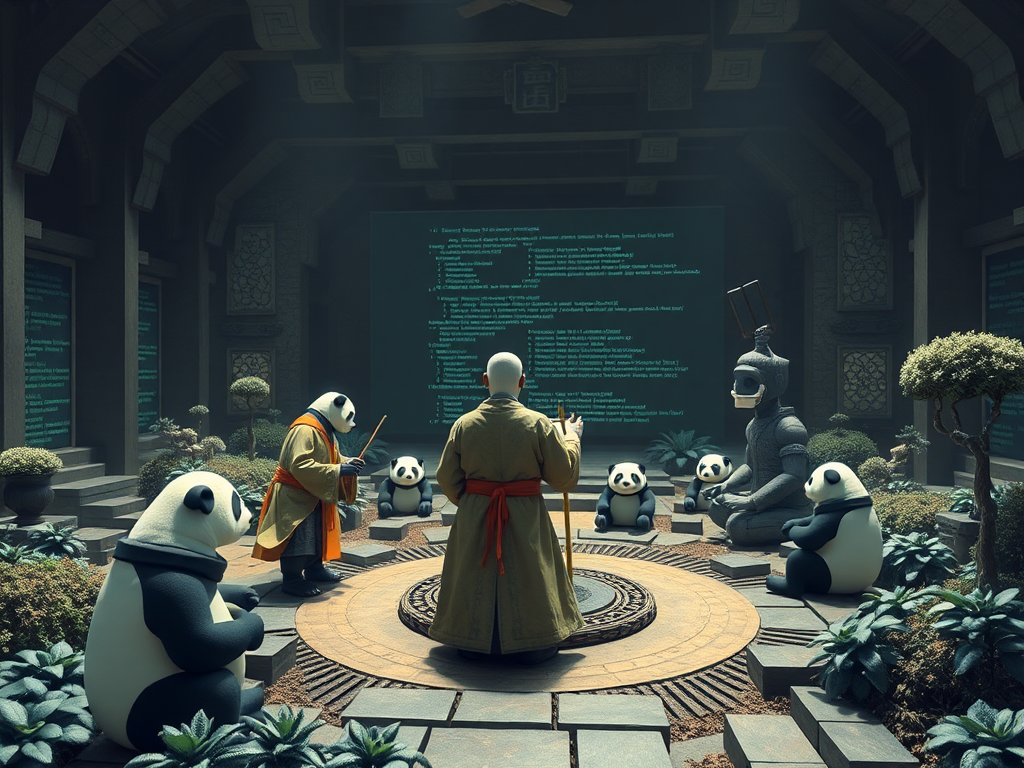Hello, Python enthusiasts! Today, let's talk about the magical programming language that is Python. As a Python enthusiast, I always can't help but share the charm of this language with everyone. Python is not only simple to learn but also powerful, no wonder it's so popular in the programming world. So, let's embark on this wonderful Python journey together!
First Encounter
Do you remember the first time I encountered Python? At that time, I had just started learning programming and was overwhelmed by the complicated syntax of other languages. Until one day, I met Python, it was like discovering an oasis in the desert! Its syntax was so concise and clear that I instantly fell in love with this language.
Python's creator, Guido van Rossum, once said: "Python is a language that lets you work quickly." This quote really resonates with me! Have you felt the charm of Python that's almost like a natural language?
Take a look at this simple example:
print("Hello, World!")
Just like that, you've written your first Python program! Compared to other languages, doesn't it feel particularly friendly?
Basics
Speaking of Python basics, I must mention its data types. Python's data types are like carefully designed tools, each with its unique use.
Let's look at the most basic ones first:
- Integers (int): such as 1, 100, -30
- Floating-point numbers (float): like 3.14, -0.01
- Strings (str): "Hello", 'Python'
- Boolean values (bool): True, False
These data types may seem simple, but they can be combined to create endless possibilities. They're like Lego blocks, you can use them to build any program structure you want.
I particularly like Python's lists and dictionaries. They're like treasure chests, able to store all kinds of data.
my_list = [1, "Python", 3.14, True]
my_dict = {"name": "Python", "year": 1991, "is_awesome": True}
You see, isn't it very intuitive? I was amazed the first time I used these data structures. They're not only easy to understand but also extremely flexible, able to meet various complex data storage needs.
Coding Standards
When it comes to Python, we can't help but mention PEP 8. PEP stands for "Python Enhancement Proposal", and PEP 8 is the official Python code style guide. You might ask, why do we need to follow a coding standard?
Imagine if everyone wrote code according to their own preferences, how difficult would team collaboration become! It's like a band, if everyone played according to their own rhythm, the result would surely be a mess. PEP 8 is like a conductor, making all Python code harmonious and consistent.
PEP 8 covers many aspects, including naming conventions, code layout, etc. For example, it suggests using underscores to separate words in function and variable names, rather than using camel case.
def calculate_average(number_list):
pass
def calculateAverage(numberList):
pass
Which way do you think is easier to read? I personally prefer the underscore method, it feels more in line with Python's concise style.
Also, PEP 8 suggests adding spaces on both sides of operators, which can make the code look neater:
x = 5
y = x + 1
x=5
y=x+1
These seemingly trivial details can greatly improve the readability of the code. I remember when I first started writing Python, I often ignored these standards. It wasn't until one day when I needed to read someone else's code that I truly appreciated the importance of following a unified standard.
Advanced Features
Python's advanced features are truly a treasure trove, with each exploration revealing new surprises. Let's take a look at some of the highlights!
Functional Programming
Although Python is not a pure functional programming language, it provides many features that support functional programming. For example, functions in Python are first-class citizens, which means you can pass functions as arguments or assign functions to variables.
Let's look at a simple example:
def apply_twice(func, arg):
return func(func(arg))
def add_five(x):
return x + 5
print(apply_twice(add_five, 10)) # Output: 20
In this code, we define an apply_twice function that takes a function and an argument as input, then applies this function twice. This is the charm of higher-order functions!
Additionally, Python provides some very useful functional programming tools, such as map(), filter(), and reduce(). These functions allow us to process data in a more concise way.
numbers = [1, 2, 3, 4, 5]
squared = list(map(lambda x: x**2, numbers))
print(squared) # Output: [1, 4, 9, 16, 25]
Look, with just one line of code, we've completed the square operation for the entire list! This programming style is not only concise but also very elegant.
Object-Oriented Programming
Python's object-oriented programming (OOP) features are also very powerful. By defining classes and objects, we can organize data and methods that operate on data together, making our code more modular and reusable.
Let's look at a simple class definition:
class Dog:
def __init__(self, name):
self.name = name
def bark(self):
return f"{self.name} says Woof!"
my_dog = Dog("Buddy")
print(my_dog.bark()) # Output: Buddy says Woof!
This example defines a Dog class with a name attribute and a bark method. In this way, we can create multiple Dog objects, each with its own name and bark.
Python's OOP also supports advanced features like inheritance and polymorphism, allowing us to build complex class hierarchies and achieve code reuse and extension.
Exception Handling
Python's exception handling mechanism is also very powerful. By using try, except, else, and finally statements, we can elegantly handle various possible error situations.
try:
result = 10 / 0
except ZeroDivisionError:
print("Cannot divide by zero!")
else:
print(f"The result is {result}")
finally:
print("This will always be executed")
In this example, we try to perform a division by zero operation. Python will catch this ZeroDivisionError exception and execute the corresponding handling code. The else clause is executed when no exception occurs, while the finally clause is executed whether an exception occurs or not.
This exception handling mechanism allows us to better control the flow of the program and improve the robustness of the code. I remember when I first started programming, I often ignored error handling. It wasn't until one day when my program crashed due to an unhandled exception that I realized the importance of exception handling.
Best Practices
When it comes to Python best practices, I have to mention code refactoring, unit testing, and performance optimization. These might sound a bit advanced, but they're all about making our code more robust, reliable, and efficient.
Code Refactoring
Code refactoring is a continuous process of improving code quality. It's not about adding new features, but about making the code easier to understand and maintain. I often spend some time refactoring after writing a piece of code.
For example, we might find some repeated code fragments:
def process_data1(data):
# Some processing logic
result = data * 2
print(f"Processing data1: {result}")
return result
def process_data2(data):
# Some processing logic
result = data * 2
print(f"Processing data2: {result}")
return result
Through refactoring, we can extract the common logic:
def process_data(data, name):
result = data * 2
print(f"Processing {name}: {result}")
return result
def process_data1(data):
return process_data(data, "data1")
def process_data2(data):
return process_data(data, "data2")
This not only reduces code duplication but also makes future modifications easier. If we need to change the processing logic, we only need to modify one place.
Unit Testing
Unit testing is another important tool for ensuring code quality. By writing test cases, we can verify whether each function or method works as expected. Python's built-in unittest module makes writing and running tests very simple.
import unittest
def add(a, b):
return a + b
class TestAddFunction(unittest.TestCase):
def test_add_positive_numbers(self):
self.assertEqual(add(1, 2), 3)
def test_add_negative_numbers(self):
self.assertEqual(add(-1, -1), -2)
if __name__ == '__main__':
unittest.main()
This example defines a simple add function, then writes two test cases to verify its behavior. By running these tests, we can quickly discover potential problems.
I remember once I modified the implementation of a function, thinking it was perfect. But when I ran the unit tests, I found that several test cases failed. This allowed me to discover a potential bug in time, preventing it from being introduced into the production environment.
Performance Optimization
Although Python is known for its simplicity and ease of use, in some cases, its performance may not be as good as some compiled languages. Therefore, it's very important to understand how to optimize Python code performance.
A common optimization technique is to use generators instead of lists, especially when dealing with large amounts of data:
def squares_list(n):
return [x**2 for x in range(n)]
def squares_generator(n):
for x in range(n):
yield x**2
for square in squares_list(1000000):
pass
for square in squares_generator(1000000):
pass
Generators don't generate all values at once, but generate them as needed, which can greatly reduce memory usage.
Another optimization technique is to use built-in functions and modules. For example, using the Counter class from the collections module to count:
from collections import Counter
words = ['apple', 'banana', 'apple', 'cherry', 'banana', 'date']
word_counts = Counter(words)
print(word_counts) # Output: Counter({'apple': 2, 'banana': 2, 'cherry': 1, 'date': 1})
This is much faster than writing our own loop to count, and the code is more concise.
I remember once I wrote a program to process a large amount of data, and it ran very slowly. By applying these optimization techniques, I successfully reduced the running time by 80%! This made me deeply realize the importance of performance optimization.
Ecosystem
Python's ecosystem is one of its biggest advantages. Rich third-party libraries and frameworks allow Python to be applied in various fields, from web development to data science, from artificial intelligence to game development, Python can handle it all.
Common Libraries and Frameworks
In the field of web development, Django and Flask are two of the most popular frameworks. Django is an all-in-one framework that provides many ready-to-use features, while Flask is more lightweight and flexible.
from django.http import HttpResponse
def hello(request):
return HttpResponse("Hello, Django!")
from flask import Flask
app = Flask(__name__)
@app.route('/')
def hello():
return "Hello, Flask!"
In the field of data science, NumPy, Pandas, and Matplotlib are three essential libraries. NumPy provides efficient numerical computing tools, Pandas makes data processing simple, and Matplotlib is used for data visualization.
import numpy as np
import pandas as pd
import matplotlib.pyplot as plt
data = pd.DataFrame({'x': np.random.rand(100), 'y': np.random.rand(100)})
plt.scatter(data['x'], data['y'])
plt.show()
In the field of artificial intelligence, TensorFlow and PyTorch are two of the most popular deep learning frameworks. They both provide powerful tools for building and training neural networks.
import tensorflow as tf
model = tf.keras.Sequential([
tf.keras.layers.Dense(64, activation='relu', input_shape=(10,)),
tf.keras.layers.Dense(64, activation='relu'),
tf.keras.layers.Dense(1)
])
model.compile(optimizer='adam', loss='mse')
These libraries and frameworks greatly extend Python's capabilities, allowing us to quickly develop various complex applications. I remember the first time I used Pandas to process a large amount of data, the feeling of efficiency improvement was simply exhilarating!
Package Management and Virtual Environments
In Python, package management and virtual environments are two very important concepts. pip is Python's package management tool, which allows us to easily install, upgrade, and remove Python packages.
pip install numpy pandas matplotlib
Virtual environments allow us to create separate Python environments for each project, avoiding dependency conflicts between different projects. venv is Python's built-in virtual environment tool:
python -m venv myenv
source myenv/bin/activate # On Linux or macOS
myenv\Scripts\activate.bat # On Windows
Using virtual environments can make our projects more independent and portable. I once encountered various problems when running the same project on different machines because I didn't use virtual environments. Since I started using virtual environments, these problems have never appeared again.
Community Resources
Python has a very active and friendly community. No matter what problem you encounter, you can always find answers on Stack Overflow or the official Python forum. In addition, Python has a large number of online tutorials, blogs, and video resources.
I especially recommend the official Python documentation, which not only contains detailed language references but also many useful tutorials. PyCon (Python Conference) is another great place to learn and communicate, where you can hear speeches from Python experts from all over the world.
I remember the first time I attended PyCon, I was deeply attracted by the atmosphere there. Seeing so many people passionate about Python, sharing their knowledge and experience, made me feel the charm of the Python community.
Conclusion
Python is truly a magical language, isn't it? From simple "Hello, World!" to complex machine learning models, Python can handle it all with ease. Its conciseness and elegance make programming a pleasure, not a burden.
Looking back on my Python learning journey, every step was full of surprises and gains. From initially being attracted by its concise syntax to later deeply exploring its advanced features; from coding alone to joining the vibrant Python community, along this journey, Python not only taught me programming but also changed the way I look at and solve problems.
However, the Python learning journey is endless. Technology is constantly evolving, and Python is constantly evolving too. For example, have you tried the many new features that came with the recent release of Python 3.9? Or are you interested in Python's applications in artificial intelligence and big data?
I sincerely hope this article can spark your interest and passion for Python. Whether you're a beginner or an experienced programmer, Python has many areas worth exploring. So, are you ready to continue your Python journey? Let's explore and grow together in this wonderful Python world!
What do you think about Python? Do you have any interesting Python experiences you'd like to share? Or have you encountered any challenges in your Python learning process? Feel free to leave a comment in the comment section, let's discuss and learn together!
Remember, in the world of Python, we are all lifelong learners. Keep your curiosity, be brave to try, and believe that you will surely have more exciting discoveries on your Python journey. Let's use Python to change the world together!




 Previous
Previous 




